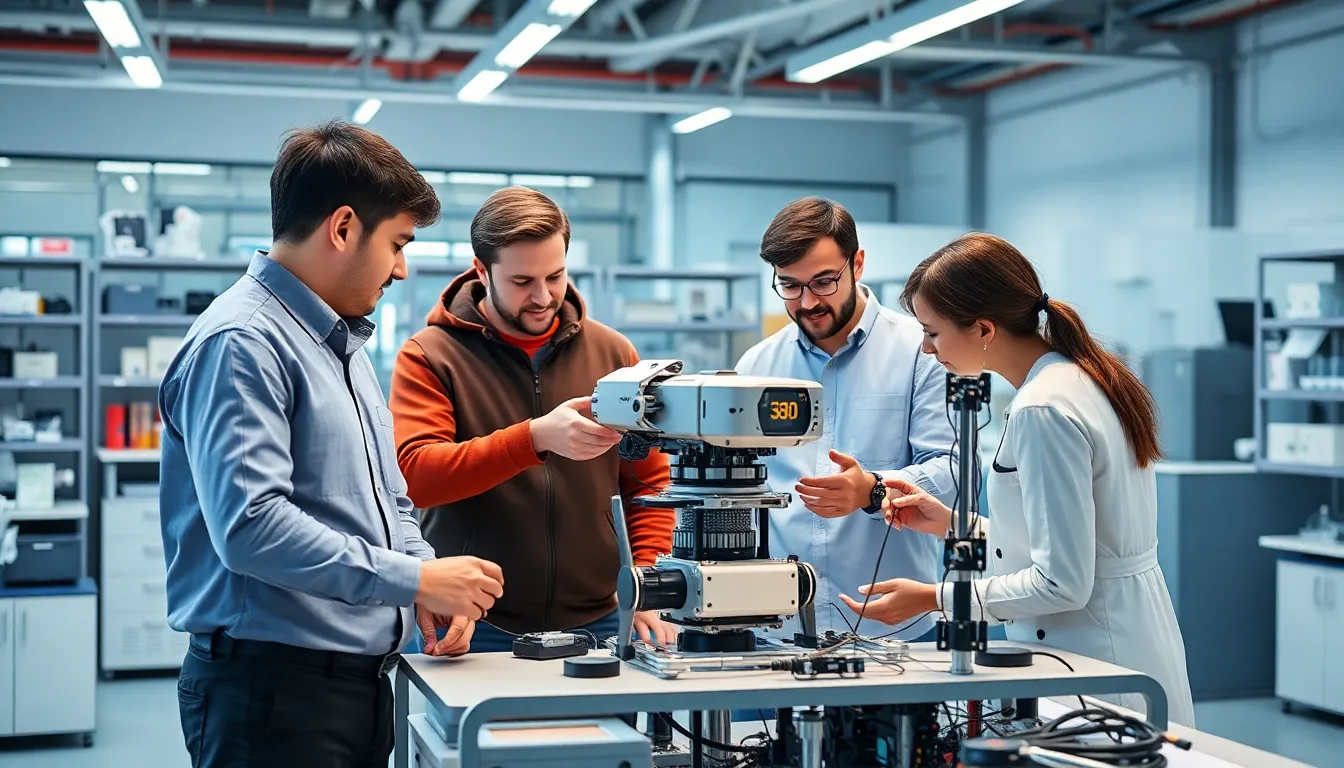In a world where robots are no longer just the stuff of sci-fi movies, ROS (Robot Operating System) is leading the charge into the future. Imagine a platform that empowers developers to create smarter, more efficient robots without breaking a sweat. It’s like giving a robot a brain upgrade while you sip your coffee.
Table of Contents
ToggleOverview of ROS Robotics
ROS, or Robot Operating System, provides essential frameworks for developing software in robotic systems. This platform offers services designed for handling hardware abstraction, low-level device control, and implementation of commonly used functionalities in robotics.
Developers benefit from a vast library of tools and packages that simplify programming tasks. These resources include powerful algorithms for tasks such as navigation, manipulation, and perception. Consequently, developers can focus on creating innovative applications without starting from scratch.
Flexibility stands out as a key feature of ROS. It supports multiple programming languages like Python and C++, enabling developers to choose the best fit for their projects. Community contributions enhance the platform’s capabilities through a rich ecosystem of shared code, making it easier to find solutions.
Modularity represents another significant advantage in ROS robotics. Individual components can be developed and tested independently, promoting efficient debugging and integration. As a result, teams can work concurrently on various parts of the system, speeding up overall development.
In industrial settings, ROS has transformed how robots operate. It supports interoperability across different robot platforms, allowing seamless integration of diverse robotic systems from various manufacturers. This compatibility strengthens the automation of complex tasks, ultimately leading to increased productivity.
Research institutions also leverage ROS for its extensive capabilities. Advanced features support experimental designs and prototyping, encouraging innovation in robotics research. This accessibility allows researchers to explore new technologies and methodologies effectively.
Applications of ROS are vast, spanning from autonomous vehicles to drones and service robots. Each application benefits from the platform’s rich feature set, driving advancements in various fields like healthcare, agriculture, and manufacturing.
Key Features of ROS Robotics

ROS (Robot Operating System) possesses several key features that significantly enhance robotic development. Its modular architecture and middleware capabilities play crucial roles in enabling advanced functionalities.
Modular Architecture
Modular architecture allows diverse components to function together seamlessly. Developers design each module independently, promoting efficiency in debugging and testing processes. Independent creation of modules leads to faster iteration and integration cycles, empowering teams to innovate. The clear separation of functionalities facilitates collaboration among developers, as anyone can work on different modules without impacting others. This structure supports a wide range of robotic applications, ensuring adaptability across various use cases.
Middleware Capabilities
Middleware capabilities serve as a bridge between hardware and software components. ROS ensures smooth communication across different systems and devices through standardized messages. This standardized approach simplifies integration of various sensors, actuators, and algorithms used in robotic systems. Effective middleware enables developers to focus on application-specific functionalities, reducing the complexity of underlying interactions. As a result, projects benefit from improved performance, scalability, and maintenance, allowing for more robust robotic solutions.
Applications of ROS Robotics
ROS robotics finds extensive applications across various sectors. Its versatility enhances both productivity and creativity in robotic solutions.
Industrial Automation
Industrial automation thrives on ROS capabilities. Factories benefit from elevated efficiency through automated processes. Using ROS, different robot systems operate seamlessly together. Collaborative robots, or cobots, integrate into existing workflows, decreasing downtime. Automotive manufacturing illustrates this application well, as robotic arms handle assembly tasks with precision. Customized solutions arise from ROS flexibility, enabling tailored approaches for diverse industries. Overall, ROS robotics drives productivity and innovation in industrial settings.
Research and Development
Research and development sectors harness ROS to encourage groundbreaking innovations. Countless academic and research institutions develop advanced robotic systems using the platform. In robotics research, ROS fosters collaboration, allowing teams to share resources and knowledge easily. Simultaneously, students gain valuable experience by utilizing real-world tools and frameworks. Various projects explore autonomous navigation and manipulation tasks, revealing new frontiers in technology. The research community contributes to the ROS ecosystem, creating a feedback loop that continually enhances the platform’s capabilities. As a result, ROS remains integral to advancing robotics research and education.
Getting Started with ROS Robotics
Getting started with ROS robotics involves understanding the essential components and tools necessary for effective development. This section provides a concise overview of installation and foundational concepts.
Installation Guide
Installing ROS requires a few straightforward steps. Begin by selecting an appropriate version, such as ROS Noetic or ROS 2 Foxy, based on system compatibility. Use terminal commands to add the ROS repository and install the necessary packages. Following installation instructions specific to the operating system is crucial, as steps vary between Ubuntu, macOS, and Windows. Setting up the environment can streamline the development process, ensuring the correct configurations. Following these guidelines prepares developers for successful robotics projects.
Basic Concepts and Tools
Grasping basic concepts is vital for efficient ROS robotics development. Nodes represent individual processes that perform specific tasks, allowing for modularity. Topics serve as communication channels between nodes, facilitating information exchange. Launch files enable developers to start multiple nodes simultaneously, enhancing project organization. Tools like RViz and Gazebo offer visualization and simulation capabilities, making debugging simpler. Utilizing these basic components lays a solid foundation for building complex robotic systems, driving productivity and innovation.
Future of ROS Robotics
Advancements in ROS robotics are poised to redefine numerous industries. Increased automation is becoming an essential element in sectors like healthcare and agriculture. The integration of artificial intelligence with ROS enhances robotic capabilities significantly. More intuitive interfaces simplify interactions for users, allowing for broader accessibility.
Development in cloud-based solutions offers scalable infrastructure, enhancing the effectiveness of robotic systems. As Internet of Things (IoT) technologies expand, synchronization between robots and other devices improves operational efficiency. Research institutions continue leveraging ROS for experiments, driving innovation in fields such as autonomous navigation and machine learning.
Safety standards in robotics are evolving, guiding the certification processes of robotic systems. Enhanced safety measures encourage broader adoption of robots in public spaces and workplaces. Community-driven growth fosters collaboration, which leads to faster advancements in ROS tools and resources. Offerings from the developer community will grow, bolstering the ROS ecosystem.
Robotics education is increasingly integrated into academic programs, preparing the next generation of innovators. With more universities providing hands-on experiences with ROS, students gain valuable skills. Companies recognize the importance of investing in skilled professionals familiar with ROS, thus contributing to industry development.
As ROS continues to evolve, it shapes the future landscape of robotics, driving efficiency, safety, and collaboration across various sectors. Continuous advancements lay the groundwork for a new era in robotic applications, influencing how society engages with technology.
The impact of ROS robotics is undeniable as it continues to revolutionize the way developers approach robotics. Its modular architecture and extensive library of tools empower creators to innovate and streamline their projects effectively.
As industries embrace automation and AI integration, the role of ROS becomes even more critical. The collaborative spirit within the ROS community fosters rapid advancements and ensures that developers have access to the latest resources.
With the ongoing evolution of ROS, the future of robotics looks promising. It’s paving the way for smarter solutions in healthcare, agriculture, and beyond, ultimately transforming how robots interact with the world around them.





